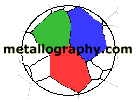

|
Figure 17. Microstructure of white cast iron containing massive cementite (white) and pearlite etched with 4% nital, 100x. |
Figure 18a shows a higher magnification view of this specimen etched with 4% nital. The massive cementite particles are clearly visible appearing to be outlined by the etch. Actually, the cementite is not attacked by the etch, while the surrounding structure is. The 'outline' around the cementite particles is due to light being scattered from the height difference or 'step' around the particles. Note that ferrite surrounds each cementite particle due to local decarburization. The pearlite is colored.

|
Figure 18a. High magnification view (400x) of the white cast iron specimen shown in Figure 17, etched with 4% nital. |
Figure 18b shows the effect of etching this specimen with alkaline sodium picrate which colors the massive cementite brown. The cementite in the pearlite constituent is colored tan and blue. Ferrite is not colored.

|
Figure 18b. High magnification view (400x) of the white cast iron specimen shown in Figure 17, etched with alkaline sodium picrate. |
Conclusions
Modern polishing materials and procedures can be employed very effectively
to reveal the microstructure of cast iron specimens. Graphite retention,
always a problem with these metals, can be accomplished with a minimum of
difficulty. Crossed polarized light is very useful for observing graphite
substructure. Etching brings out the matrix constituents.
Selective etching with color producing films, briefly discussed here, is a highly informative tool. This will be discussed in more detail in a future issue.
Acknowledgments
Specimens for Figures 3, 16, 17, and 18 were provided by St. Fuksa and W.
Wierzchowski, Foundry Research Institute, Kraków, Poland.
| Go to: | [FAQ] | [Home] | [Beginning of Article] |